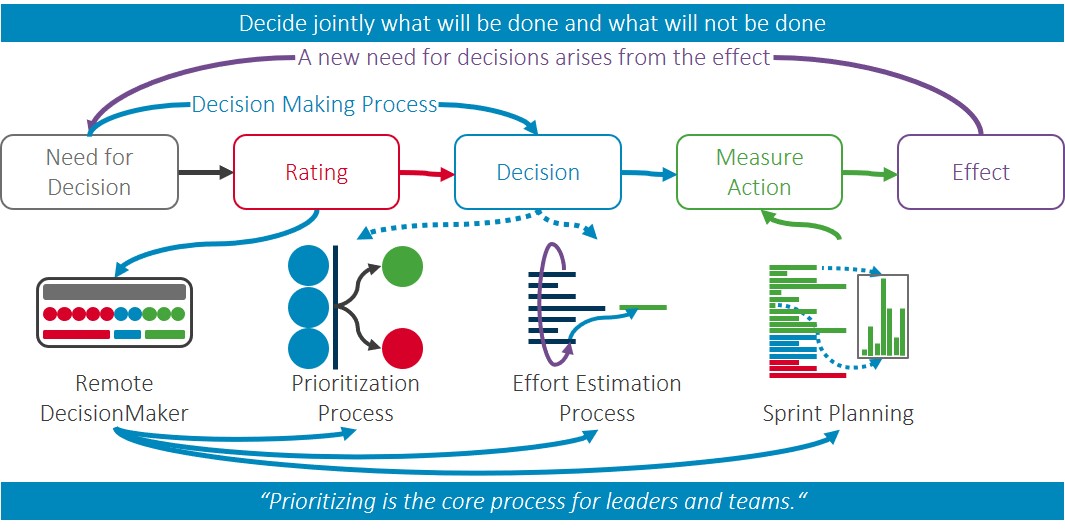Prioritizing to Decide What to Do and What Not to Do
How can everyone jointly decide what can successfully be achieved with existing resources?
Failure to master the Prioritization Process leads to stress and failure. People are reluctant to commit if they’re overloaded and unsure about what they’re supposed to do. Overload causes burnout.
Additionally, people in an organization may feel like they are competing for limited resources, such as time, budget, headcount, competencies, and implementation capacities. The battle burdens and overwhelms people and complicates projects.
Using the DecisionMaker eliminates these battles. You can use the DecisionMaker to bring about a jointly supported prioritization for stories or tasks. You can also bring about jointly supported decisions regarding how much effort is needed to complete these stories or tasks. Both elements are necessary for planning.
How does the DecisionMaker work here?
Prioritization can’t be done with intuition, you need a reliable cognitive process. Digitized Decision Making (dDMM) offers a whole set of Decision Making Processes to make prioritization reliable and prompt.
The DecisionMaker can be harnessed to leverage the proper order of making prioritizations, then commitments. Making a decision requires the prioritization of options first, but this itself requires decisions made with ratings. This has been a universal dilemma for all people, whether employees, managers or agile teams. Using the DecisionMaker solves this dilemma and accelerates prioritization by 2X to 5X.
The DecisionMaker allows you to prioritize and estimate tasks in a project or stories in sprint. Subsequently, the planning is done with the existing resources. The result is that all participants become aligned with agreed-upon, realistic goals and achieve maximum benefit, because they are willing to commit to implementation.

How do I use it?
First, define your prioritization-id as a KiE Number. For example, if you care about tracking urgency and importance, the KiE Number can represent a combination of both in the rating process. Next, create a KiE Scale for prioritization, with the leading question such as “How important and urgent is the topic for you, your team and the company” and KiE Scale Type “right”. Choose your meaning such as “necessary”, “reasonable” and “not so important”.
Select the KiE Scales in this order for your Prioritization Process.
- Make a rating for the understanding and use the Resource Question to ensure that everyone has the same understanding of stories and tasks.
- Make the first prioritization with the KiE Scale, it immediately shows how close everybody is to making a jointly-supported priority. Based on the result, collect arguments for low and high priorities bring further information to the team. This can be done with the KiE Scale Type Question as well as in a dialog. Typically, experienced teams need one to two iterations.
- You make a proposal for the prioritization-id and make a Commitment Process for the priority.
- After the commitments for a priority, you can estimate the effort with the team in the same way. Use for estimation the KiE Scale Type “fibonacci”.
Subsequently, the planning is done with the existing resources and mapped with the committed prioritization and the estimation for the stories.
The DecisionMaker’s Composed Decision Making Process allows you to save your most frequently used Decision Making Processes like the Prioritization Process as a composed Decision Making Process (cDMp).
- Create a cDMp, select “CREATE COMPOSED DM PROCESS.” Type a title for your Process select “CREATE”.
- Choose the KiE Scales for understanding, prioritization, commitment and collecting information with these cDMp. The team will learn best with a repeated Prioritization Process.
As a result, the team has a jointly-supported sequence: What has to be done, what will not be done, and the order in which to tackle what has to be done.